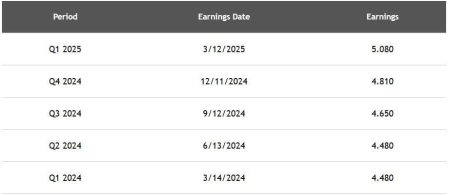Meta Platforms’ Stock Performance and Growth Drivers:
Meta Platforms (META), the parent company of Facebook, Instagram, and WhatsApp, has experienced significant stock market fluctuations in recent years. While the stock has delivered impressive returns of 83% since early 2022, surpassing the S&P 500’s 28% gain, this growth has not been consistent. The stock’s volatility is evident in its annual returns: 23% in 2021, a sharp decline of -64% in 2022, and a substantial rebound of 194% in 2023. This erratic performance underscores the company’s sensitivity to market dynamics and its own strategic shifts. The recent 5% uptick in META’s stock price over the past month can be partly attributed to investor optimism surrounding the potential ban of TikTok in the U.S. This potential ban could reduce competition in the social media landscape, benefiting Meta’s market share.
The substantial growth in META’s stock price since early 2022 can be primarily attributed to two key factors: a 54% increase in earnings per share, rising from $13.77 in 2021 to $21.17 currently, and a 19% expansion in the company’s price-to-earnings (P/E) ratio, moving from 24.4x to 29x during the same period. These figures highlight the company’s improved financial performance and the market’s positive perception of its future prospects. The earnings growth stems from a combination of increased revenue, margin expansion, and a reduction in outstanding shares through share repurchases.
Revenue Growth and Profitability:
Meta’s core business model revolves around advertising revenue, generated by targeting specific demographics based on user data. The company’s revenue has surged by 32.5% from $118 billion in 2021 to $156 billion in the last twelve months. This impressive growth is driven by a combination of increasing ad impressions and a higher average price per ad. Meta’s user base, measured by daily active people across its family of apps, has also grown significantly, increasing by 17% from 2.82 billion in 2021 to 3.29 billion currently. This expanding user base fuels the platform’s advertising potential and contributes to its revenue growth. Further bolstering its profitability, Meta’s net income margin has expanded from 33.4% in 2021 to 35.6% currently, demonstrating increased efficiency in converting revenue to profit.
The company’s strategic investments in artificial intelligence (AI) have played a significant role in driving both user engagement and targeted advertising. Meta’s AI initiatives focus on enhancing content generation, improving ad targeting accuracy, and boosting user experience, ultimately leading to higher advertising revenues. The potential TikTok ban in the U.S., although facing legal challenges, could further benefit Meta by minimizing competition and potentially attracting TikTok users to its platforms. However, the recent emergency motion filed by ByteDance, TikTok’s parent company, seeking to block the ban adds uncertainty to this scenario.
Valuation and Future Outlook:
Despite the significant year-to-date gains in META’s stock price, reaching around $615 and marking a 74% increase, the company’s valuation is a subject of debate. Currently trading at 29x trailing earnings, compared to its average P/E ratio of 22x over the past four years, META’s stock appears to be fully valued, or even slightly overvalued, according to some analysts. While the recent advertising growth and promising potential of AI investments justify some premium, the uncertainty surrounding the long-term impact of AI on earnings growth warrants caution. The aggressive investments in AI, while potentially lucrative, also represent a degree of risk if the expected returns do not materialize.
The current macroeconomic environment, characterized by uncertainties around interest rate cuts and geopolitical tensions, adds further complexity to META’s future outlook. The stock’s past volatility underscores its susceptibility to market fluctuations and raises questions about its potential performance in the next 12 months. While the stock’s recent performance has been strong, investors should consider the potential risks and the company’s relatively high valuation compared to its historical average. A comparison with industry peers and a deeper analysis of Meta’s financial metrics can offer further insights into its true value and future prospects.
The Role of AI and the TikTok Ban:
Meta’s investments in AI are a central part of its growth strategy. The company aims to leverage AI to enhance user engagement, refine ad targeting, and potentially generate new revenue streams. While the long-term impact of these investments remains to be seen, the potential for AI to drive further growth is significant. The possible TikTok ban in the U.S. also presents a potential catalyst for Meta’s growth. By removing a major competitor, a TikTok ban could shift a significant portion of users and advertising revenue to Meta’s platforms, strengthening its market dominance. However, the legal challenges surrounding the ban introduce an element of uncertainty. ByteDance’s emergency motion to block the ban underscores the ongoing legal battle and the potential for the situation to change.
Investment Considerations and Risk Assessment:
While Meta’s recent performance and growth prospects appear promising, investors should carefully evaluate the associated risks before making investment decisions. The stock’s high valuation, compared to historical averages, suggests that much of the anticipated growth is already priced in. The uncertainty surrounding the long-term impact of AI investments and the potential for further macroeconomic headwinds should also be considered. While the potential TikTok ban could benefit Meta, its realization is far from guaranteed, and investors should not rely solely on this factor. A thorough assessment of Meta’s financial performance, competitive landscape, and the broader economic context is essential for making informed investment decisions.
Peer Comparisons and Portfolio Diversification:
Comparing Meta’s performance and valuation with its industry peers can provide valuable context and help identify potential investment opportunities. Analyzing key metrics, such as revenue growth, profitability, and valuation multiples, across comparable companies can reveal relative strengths and weaknesses. Furthermore, diversifying investments across a portfolio of stocks can mitigate risk and enhance returns. By spreading investments across different sectors and companies, investors can reduce the impact of individual stock fluctuations and achieve more stable overall portfolio performance. A diversified portfolio, including stocks with varying levels of risk and return potential, can offer a more balanced and resilient investment strategy.










